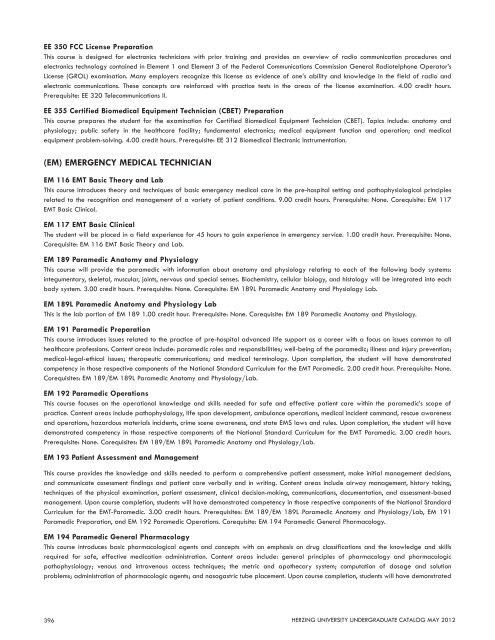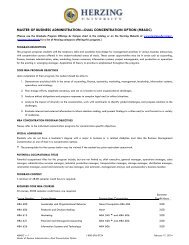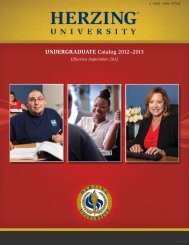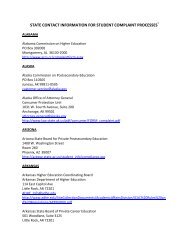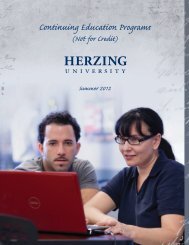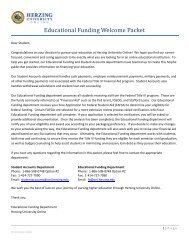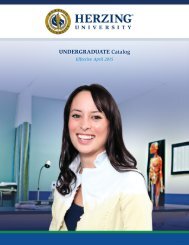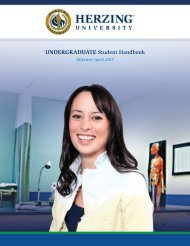Undergraduate - Herzing University
Undergraduate - Herzing University
Undergraduate - Herzing University
You also want an ePaper? Increase the reach of your titles
YUMPU automatically turns print PDFs into web optimized ePapers that Google loves.
EE 350 FCC License PreparationThis course is designed for electronics technicians with prior training and provides an overview of radio communication procedures andelectronics technology contained in Element 1 and Element 3 of the Federal Communications Commission General Radiotelphone Operator’sLicense (GROL) examination. Many employers recognize this license as evidence of one’s ability and knowledge in the field of radio andelectronic communications. These concepts are reinforced with practice tests in the areas of the license examination. 4.00 credit hours.Prerequisite: EE 320 Telecommunications II.EE 355 Certified Biomedical Equipment Technician (CBET) PreparationThis course prepares the student for the examination for Certified Biomedical Equipment Technician (CBET). Topics include: anatomy andphysiology; public safety in the healthcare facility; fundamental electronics; medical equipment function and operation; and medicalequipment problem-solving. 4.00 credit hours. Prerequisite: EE 312 Biomedical Electronic Instrumentation.(EM) Emergency medical technicianEM 116 EMT Basic Theory and LabThis course introduces theory and techniques of basic emergency medical care in the pre-hospital setting and pathophysiological principlesrelated to the recognition and management of a variety of patient conditions. 9.00 credit hours. Prerequisite: None. Corequisite: EM 117EMT Basic Clinical.EM 117 EMT Basic ClinicalThe student will be placed in a field experience for 45 hours to gain experience in emergency service. 1.00 credit hour. Prerequisite: None.Corequisite: EM 116 EMT Basic Theory and Lab.EM 189 Paramedic Anatomy and PhysiologyThis course will provide the paramedic with information about anatomy and physiology relating to each of the following body systems:integumentary, skeletal, muscular, joints, nervous and special senses. Biochemistry, cellular biology, and histology will be integrated into eachbody system. 3.00 credit hours. Prerequisite: None. Corequisite: EM 189L Paramedic Anatomy and Physiology Lab.EM 189L Paramedic Anatomy and Physiology LabThis is the lab portion of EM 189 1.00 credit hour. Prerequisite: None. Corequisite: EM 189 Paramedic Anatomy and Physiology.EM 191 Paramedic PreparationThis course introduces issues related to the practice of pre-hospital advanced life support as a career with a focus on issues common to allhealthcare professions. Content areas include: paramedic roles and responsibilities; well-being of the paramedic; illness and injury prevention;medical-legal-ethical issues; therapeutic communications; and medical terminology. Upon completion, the student will have demonstratedcompetency in those respective components of the National Standard Curriculum for the EMT Paramedic. 2.00 credit hour. Prerequisite: None.Corequisites: EM 189/EM 189L Paramedic Anatomy and Physiology/Lab.EM 192 Paramedic OperationsThis course focuses on the operational knowledge and skills needed for safe and effective patient care within the paramedic’s scope ofpractice. Content areas include pathophysiology, life span development, ambulance operations, medical incident command, rescue awarenessand operations, hazardous materials incidents, crime scene awareness, and state EMS laws and rules. Upon completion, the student will havedemonstrated competency in those respective components of the National Standard Curriculum for the EMT Paramedic. 3.00 credit hours.Prerequisite: None. Corequisites: EM 189/EM 189L Paramedic Anatomy and Physiology/Lab.EM 193 Patient Assessment and ManagementThis course provides the knowledge and skills needed to perform a comprehensive patient assessment, make initial management decisions,and communicate assessment findings and patient care verbally and in writing. Content areas include airway management, history taking,techniques of the physical examination, patient assessment, clinical decision-making, communications, documentation, and assessment-basedmanagement. Upon course completion, students will have demonstrated competency in those respective components of the National StandardCurriculum for the EMT-Paramedic. 3.00 credit hours. Prerequisites: EM 189/EM 189L Paramedic Anatomy and Physiology/Lab, EM 191Paramedic Preparation, and EM 192 Paramedic Operations. Corequisite: EM 194 Paramedic General Pharmacology.EM 194 Paramedic General PharmacologyThis course introduces basic pharmacological agents and concepts with an emphasis on drug classifications and the knowledge and skillsrequired for safe, effective medication administration. Content areas include: general principles of pharmacology and pharmacologicpathophysiology; venous and intravenous access techniques; the metric and apothecary system; computation of dosage and solutionproblems; administration of pharmacologic agents; and nasogastric tube placement. Upon course completion, students will have demonstrated396 <strong>Herzing</strong> UNIVERSITY undergraduate Catalog May 2012


